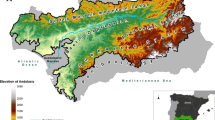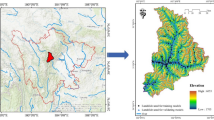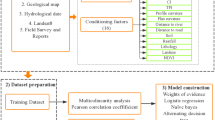Abstract
Bayesian network has a powerful ability for reasoning and semantic representation, which combined with qualitative analysis and quantitative analysis, with prior knowledge and observed data, and provides an effective way to deal with prediction, classification and clustering. Firstly, this paper presented an overview of Bayesian network and its characteristics, and discussed how to lean a Bayesian network structure from given data, and then constructed a Bayesian network model for land resource evaluation with expert knowledge and the dataset. The experimental results based on the test dataset are that evaluation accuracy is 87.5%, and Kappa index is 0.826. All these prove the method is feasible and efficient, and indicate that Bayesian network is a promising approach for land resource evaluation.
Similar content being viewed by others
References
Kalogirou S. Expert Systems and GIS: An Application of Land Suitability Evaluation [J].Computers, Environment and Urban Systems, 2002,26(2–3): 89–112.
Lein J K. Applying Evidential Reasoning Methods to Agricultural Land Cover Classification [J].International Journal of Remote Sensing, 2003,24(21): 4161–4180.
Braimoh A K, Vlek P L, Stein A. Land Evaluation for Maize Based on Fuzzy Set and Interpolation [J].Environmental Management, 2004,33(2): 226–238.
Ghar M A, Renchin T, Tateishi R,et al. Agricultural and Monitoring Using a Linear Mixture Model [J].International Journal of Environmental Studies, 2005,62(2): 227–234.
Liu Yaolin, Jiao Limin. Model of Land Suitability Evaluation Based on Computational Intelligence [J].Geomatics and Information Science of Wuhan University, 2005,30(4): 283–287 (Ch).
Pearl J. Fusion, Propagation, and Structuring in Belief Networks [J]. Artificial Intelligence, 1986,29(3): 241–288.
Huang Yong, Chan K L, Zhang Zhihua. Texture Classification by Multi-Model Feature Integration Using Bayesian Networks [J].Pattern Recognition Letters, 2003,24(1–3): 393–401.
Hruschka J E, Hruschka E R, Ebecken N F. Feature Selection by Bayesian Networks [J].Lecture Notes in Artificial Intelligence (Subseries of Lecture Notes in Computer Science), 2004,3060: 370–379.
Solares C, Sanz A M. Bayesian Network Classifiers: An Application to Remote Sensing Image Classification [J].WSEAS Transactions on Systems, 2005,4(4): 343–348.
Baldwin J F, Di T E.Proceedings of the 12th IEEE International Conference on Fuzzy Systems [C]. Piscataway, NI, USA: IEEE Press, 2003,1: 630–635.
Heckerman D. Bayesian Network for Data Mining [J].Data Mining and Knowledge Discovery, 1997,1: 79–119.
Cheng J, Greiner R, Kelly J,et al. Learning Bayesian Networks from Data: An Information-Theory Based Approach [J].Artificial Intelligence, 2002,137(1–2): 43–90.
Wai L, Fahiem B. Learning Bayesian Belief Networks: An approach Based on the MDL Principle [J].Computational Intelligence, 1994,10: 269–293.
Singh M, Valtorta M. Construction of Bayesian Network Structures from Data: A Brief Survey and an Efficient Algorithm [J].International Journal of approximate Reasoning, 1995,12: 111–131.
Acid S, De C L, Castellano J G. Learning Bayesian Network Classifiers: Searching in a Space of Partially Directed Acyclic Graphs [J]. Machine Learning, 2005,59(3): 213–235.
Heckerman D, Geiger D, Chickering M D. Learning Bayesian Networks: The Combination of Knowledge and Statistical Data [J].Machine Learning, 1995,20(2): 197–243.
Author information
Authors and Affiliations
Corresponding author
Additional information
Foundation item: Supported by the National Natural Science Foundation of China (60175022, 40571128, 40572166)
Biography: HUANG Jiejun (1976-), male, Ph. D., research direction: spatial information fusion and data mining.
Rights and permissions
About this article
Cite this article
Jiejun, H., Xiaorong, H. & Youchuan, W. Application of bayesian network learning methods to land resource evaluation. Wuhan Univ. J. Nat. Sci. 11, 1041–1045 (2006). https://doi.org/10.1007/BF02830207
Received:
Issue Date:
DOI: https://doi.org/10.1007/BF02830207




